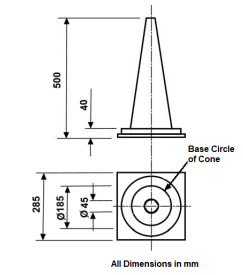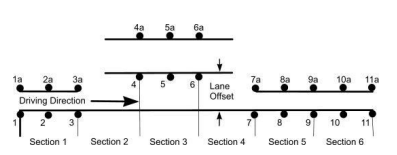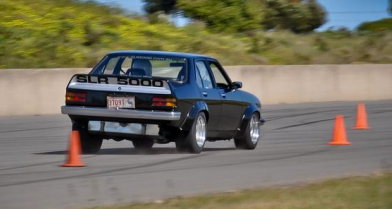On this page
These test procedures intend to subjectively determine the road-holding ability and handling characteristics of a vehicle during emergency lane change manoeuvre. These test procedures are applicable to vehicles with a gross vehicle mass of up to and including 3,500kg.
Test procedure
The testing must be conducted under the guidance of a Light vehicle engineering signatory (LVES), with proven experience in the lane change manoeuvre test. The lane change track must be negotiated by a skilled driver with automotive road testing experience. Since these are subjective tests, it is not sufficient for the driver to have negotiated the test successfully, the driver must also be confident that the vehicle is safe to drive.
The test procedure consists of driving a vehicle through a set track, which simulates an emergency lane change manoeuvre. The vehicle is driven from its initial lane to another lane, parallel to the initial lane, and then back again to the initial lane. The length of each track section remains constant, but the width of the lane varies depending on the width of the vehicle under test.
Marking of the lane change track
The lane change track shall be marked with cones complying with Figure 1, placed at points specified by Figure 2. The track limits shall be tangential to the base circles of the cones.

Figure 1. Cones for lane
change delineation

Figure 2. Placement of cones for
marking the lane change track
Lane change track dimensions
The dimensions of the track are specified in the appropriate ISO standard. Individual track segment length dimensions remain the same whilst track width varies according to the width of the vehicle under test (refer to Table 1).
| Section | Length of section - metres | Section width - metres |
|---|---|---|
| 1 | 15.0 | 1.1 x vehicle width plus 0.25 |
| 2 | 30.0 | |
| 3 | 25.0 | 1.2 x vehicle width plus 0.25 |
| 4 | 25.0 | |
| 5 | 15.0 | 1.3 x vehicle width plus 0.25 |
| 6 | 15.0 | 1.3 x vehicle width plus 0.25 |
| Lane offset 3.5 metres | ||
Measuring distance for calculating average speed
The measuring distance for calculating average speed starts at the beginning of track Section 1 and finishes at the end of track Section 5 (refer to Figure 2).
Track surface
The track surface shall be sealed, dry and as hard and as planar as possible.
The anti-skid property during the test shall correspond to a skid number of at least 70, according to ASTM.
Longitudinal deviation from horizontal shall not be more than 1 degree.
Transverse deviation from horizontal shall not be more than 2 degrees.
Ambient conditions
Wind speed shall not exceed 3m/s (11 km/h).
Vehicle ‘test tare mass’
The test vehicle must be equipped with all optional equipment that is likely to increase the tare mass of the vehicle. The vehicle must also have full complements of:
- lubricants
- coolant - if required
- washer fluid
- fuel - tank to be filled to at least 90% of the capacity specified by the manufacturer.
If offered as standard equipment, the following equipment must also be included in the vehicle:
- spare wheel
- fire extinguisher
- wheel chocks
- standard tool kit.
The mass of a vehicle equipped as described above is the ‘test tare mass’.
Note: For the convenience of testing or in cases where an item of standard equipment is missing, an equivalent mass may be used in place of a missing item - eg a spare tyre and rim weighing 20 kg may be replaced with a 20 kg sandbag provided it is located in the spare wheel well during testing.
Test mass
- The vehicle shall be tested under two loaded conditions — vehicle test mass 1 and vehicle test mass 2 — unless the LVES can provide evidence that one test is sufficient.
- In no case must the permissible axle loads be exceeded.
- Masses must be placed in such a way as not to substantially alter the vehicle’s moment of inertia around the vertical axis.
Vehicle test mass 1
The test tare mass as defined above plus the mass of the driver. To meet this requirement, the driver must weigh at least 68kg. Where the driver’s mass is less than 68 kg, additional mass must be added to account for the difference in mass between the driver’s actual mass and 68kg.

Vehicle test mass 2
The test tare mass as per 1, plus:
- 68 kg x number of seating positions in the passenger compartment, and
- 13.5 kg x number of seating positions, uniformly distributed over the luggage compartment(s).
- Loading of the passenger compartment shall be such that wheel loads obtained correspond to wheel loads that would be obtained with loading each seat with 68 kg at its H (hip) point. Masses used for loading may be placed on the passenger compartment floor.
For goods-carrying vehicles
As per Vehicle Test Mass 1 plus sufficient ballast, uniformly distributed over the goods carrying area, to load the vehicle to its GVM.
Securing of test mass
The vehicle test mass and any additional test mass used in conformity with the vehicle test tare mass must be well secured so that there is no likelihood of any part of the load moving while the vehicle is being tested. Items required to be left in the vehicle must also be safely stowed or restrained.
Any other loose items within the vehicle, including those in the boot that are not essential to the test, must be removed from the vehicle before testing commences.
Tyre specifications and condition
The tyres used during the test must be the tyres specified in the application to modify the vehicle. The tyres must be in good condition, with full tread, and be inflated to the recommended tyre pressure before commencing the test.
Vehicle condition
The vehicle must be thoroughly checked and found to be roadworthy before it is subjected to the lane change test. Particular attention must be paid to the condition of brakes, tyres, steering and wheel alignment. The vehicle must not undergo testing until any faults that are found are satisfactorily repaired.
Prior to commencing the test, the subject vehicle must be driven by the test driver to assess whether the vehicle displays any unsatisfactory characteristics and for the driver to familiarise themselves with the vehicle and its controls.
At this stage, the test driver may refuse to drive the vehicle through the test track if the test driver is not satisfied that the vehicle is in a suitable condition.
Test
The test must be conducted by an experienced and skilled driver.
To ensure the safety of all concerned, the driver must commence testing at a speed not exceeding 80 km/h. Test speed can then be incrementally increased up to the ‘maximum test speed’, as the driver and LVES deem it safe to do so. The test speed increments must not exceed +5 km/h.
The ‘maximum test speed’ must be the lowest of the following:
- The maximum speed the vehicle can obtain, or
- 110 km/h +/- 3 km/h for all MA vehicles and all passenger cars, or
- 100 km/h +/- 3 km/h for all other vehicles, or
- The maximum speed at the vehicle is allowed to be driven either by a limitation in regulation, condition of registration, condition of a permit or posted speed limit for the vehicle in question.
The vehicle must be driven through the lane-change track according to the following conditions:
- Into the designated test lane change track at the ‘maximum test speed’ for the vehicle, and the exit speed must be stated in the test report.
- Over the test course, the throttle position must be held as steady as possible and the gear position engaged during the test shall be stated in the test report
- A successful pass through the lane-change track requires that none of the cones is displaced during the test.
Subjective assessment
Further to the above testing, a subjective report assessing the overall handling characteristics of the subject vehicle must be prepared by the test driver. The assessment shall cover the general handling of the vehicle up to legal speed limits, not just its performance in the lane change test.
The test driver must consider the degree of difficulty encountered in achieving a successful pass through the lane-change track and may recommend that the vehicle fails the test even though the vehicle may have been driven through the test track at the maximum test speed if the test driver considers the vehicle was difficult to control during the test and would be unsafe in the hands of a driver who is not an experienced test driver.
Vehicle Standards reference: MR807.

